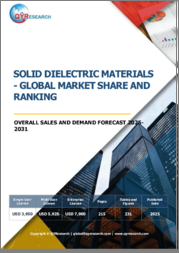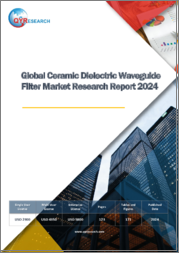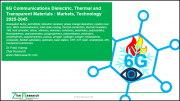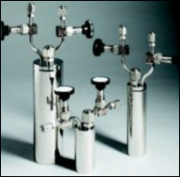
|
시장보고서
상품코드
1518862
유전체 재료 시장 : 세계 산업 분석, 규모, 점유율, 성장, 동향, 예측(2024-2032년)Dielectric Material Market: Global Industry Analysis, Size, Share, Growth, Trends, and Forecast, 2024-2032 |
||||||
Persistence Market Research는 최근 세계 유전체 재료 시장에 대한 종합적인 보고서를 발표했습니다. 이 보고서는 촉진요인, 동향, 기회 및 과제를 포함한 주요 시장 역학을 철저히 평가하고 시장 구조에 대한 심층적인 인사이트를 제공합니다.
주요 인사이트 : 유전체 재료 시장
- 시장 규모(2024년) : 608억 달러
- 예상 시장 규모(2032년) : 848억 달러
- 세계 시장 성장률(2024-2032년 CAGR) : 4.2%
유전체 재료 시장 - 보고서 범위:
유전체 재료는 전자, 통신, 자동차, 항공우주 등 다양한 산업에서 중요한 역할을 하고 있습니다. 이러한 재료는 전기 에너지의 효율적인 저장 및 전송을 가능하게 하는 전기 절연 특성에 필수적입니다. 유전체 재료 시장은 세라믹, 폴리머, 복합재료 등 다양한 재료를 제공하여 제조업체와 최종사용자를 위한 다양한 재료를 제공합니다.
시장 성장 촉진요인:
세계 유전체 재료 시장은 전자제품 수요 증가, 통신 인프라의 급속한 기술 발전, 자동차 부문 확대 등 몇 가지 주요 요인에 의해 주도되고 있습니다. 소비자 전자제품 생산의 증가와 에너지 효율 기술에 대한 관심이 높아지면서 시장 확대가 더욱 가속화되고 있습니다. 고성능 고분자 및 나노 복합재 개발 등 유전체 재료의 기술 혁신은 재료 특성을 개선하고 산업 전반에 걸쳐 응용 범위를 넓히고 있습니다.
시장 억제요인:
유전체 재료 시장은 유망한 성장 전망에도 불구하고, 원자재 비용, 환경 규제, 변동하는 공급망에 대한 도전에 직면해 있습니다. 재료공학의 복잡성과 고성능 애플리케이션에 요구되는 까다로운 품질 기준은 시장 참여자들에게 경영상의 도전을 안겨주고 있습니다. 경제적 불확실성과 지정학적 요인도 시장 역학에 영향을 미쳐 투자 결정과 시장 안정성에 영향을 미칩니다.
시장 기회:
유전체 재료 시장은 5G 기술의 발전, 전기자동차의 보급 확대, 재생에너지의 증가로 인해 큰 성장 기회를 맞이하고 있습니다. 플렉서블 전자, IoT 장치, 스마트 그리드 등 신흥 애플리케이션에 유전체 재료의 통합은 시장 잠재력을 확대할 것입니다. 전략적 파트너십, R&D 투자, 친환경적이고 비용 효율적인 재료의 도입은 새로운 기회를 활용하고 시장 리더십을 유지하는 데 있어 매우 중요합니다.
본 보고서에서 다루는 주요 질문들
- 유전체 재료 세계 시장 성장을 촉진하는 주요 요인은 무엇인가?
- 다양한 산업에서 채택이 증가하고 있는 유전체 재료의 종류와 용도는?
- 기술의 발전은 유전체 재료 시장의 경쟁 구도를 어떻게 변화시키고 있는가?
- 유전체 재료 시장에 기여하는 주요 기업은 어디에 있으며, 시장 관련성을 유지하기 위해 어떤 전략을 채택하고 있는가?
- 세계 유전체 재료 시장의 새로운 트렌드와 향후 전망은?
목차
제1장 주요 요약
제2장 시장 개요
- 시장 범위/분류
- 시장 정의/범위/제한
제3장 시장 배경
- 시장 역학
- 시나리오 예측
- 기회 맵 분석
- 투자 실현 가능성 매트릭스
- PESTLE와 Porters 분석
- 규제 상황
- 지역별 상부 시장 전망
제4장 세계의 유전체 재료 시장 분석
- 과거 시장 규모 금액(백만 달러) 분석, 2019-2023년
- 현재 및 향후 시장 규모 금액(백만 달러) 예측, 2024-2032년
- 전년비 성장 동향 분석
- 절대액 기회 분석
제5장 세계의 유전체 재료 시장 분석 : 재료별
- 소개/주요 조사 결과
- 과거 시장 규모 금액(백만 달러) 분석 : 재료별, 2019-2023년
- 현재 및 향후 시장 규모 금액(백만 달러) 분석과 예측 : 재료별, 2024-2032년
- 금속 산화물
- 기판 재료
- 액정
- 광결정
- 기타
- 전년비 성장 동향 분석 : 재료별, 2019-2023년
- 절대액 기회 분석 : 재료별, 2024-2032년
제6장 세계의 유전체 재료 시장 분석 : 기술별
- 소개/주요 조사 결과
- 과거 시장 규모 금액(백만 달러) 분석 : 기술별, 2019-2023년
- 현재 및 향후 시장 규모 금액(백만 달러) 분석과 예측 : 기술별, 2024-2032년
- E-ink 디스플레이
- TFT-LCD 디스플레이
- LED 디스플레이
- OLED 디스플레이
- LCOS 디스플레이
- 플라즈마 디스플레이
- DLP-디지털 라이트 프로세서
- 전년비 성장 동향 분석 : 기술별, 2019-2023년
- 절대액 기회 분석 : 기술별, 2024-2032년
제7장 세계의 유전체 재료 시장 분석 : 용도별
- 소개/주요 조사 결과
- 과거 시장 규모 금액(백만 달러) 분석 : 용도별, 2019-2023년
- 현재 및 향후 시장 규모 금액(백만 달러) 분석과 예측 : 용도별, 2024-2032년
- 기존 디스플레이
- 플렉서블 디스플레이
- 투명 디스플레이
- 3D 디스플레이
- 전년비 성장 동향 분석 : 용도별, 2019-2023년
- 절대액 기회 분석 : 용도별, 2024-2032년
제8장 세계의 유전체 재료 시장 분석 : 지역별
- 소개
- 과거 시장 규모 금액(백만 달러) 분석 : 지역별 2019-2023년
- 현재 시장 규모 금액(백만 달러) 분석과 예측 : 지역별, 2024-2032년
- 북미
- 라틴아메리카
- 유럽
- 아시아태평양
- 중동 및 아프리카
- 시장 매력 분석 : 지역별
제9장 북미의 유전체 재료 시장 분석 : 국가별
제10장 라틴아메리카의 유전체 재료 시장 분석 : 국가별
제11장 유럽의 유전체 재료 시장 분석 : 국가별
제12장 아시아태평양의 유전체 재료 시장 분석 : 국가별
제13장 중동 및 아프리카의 유전체 재료 시장 분석 : 국가별
제14장 주요 국가의 유전체 재료 시장 분석
- 미국
- 캐나다
- 브라질
- 멕시코
- 독일
- 영국
- 프랑스
- 스페인
- 이탈리아
- 중국
- 일본
- 한국
- 싱가포르
- 태국
- 인도네시아
- 호주
- 뉴질랜드
- GCC 국가
- 남아프리카공화국
- 이스라엘
제15장 시장 구조 분석
- 경쟁 대시보드
- 경쟁 벤치마크
- 주요 기업의 시장 점유율 분석
제16장 경쟁 분석
- 경쟁 상세 정보
- Kent Displays
- LG Display
- NEC Display Solutions
- Samsung Display
- NKT Photonics
- SCHOTT AG
- KOLON Industries
- Honeywell Electronics Materials
- Polyera Corporation
- Innovation Works
- Plastic Logic
제17장 사용되는 가정과 두문자어
제18장 조사 방법
ksm 24.08.02Persistence Market Research has recently released a comprehensive report on the worldwide Dielectric Material Market. The report offers a thorough assessment of crucial market dynamics, including drivers, trends, opportunities, and challenges, providing detailed insights into the market structure.
Key Insights: Dielectric Material Market
- Market Size (2024E): USD 60.8 Billion
- Projected Market Value (2032F): USD 84.8 Billion
- Global Market Growth Rate (CAGR 2024 to 2032): 4.2%
Dielectric Material Market - Report Scope:
Dielectric materials play a crucial role in various industries, including electronics, telecommunications, automotive, and aerospace. These materials are essential for their electrical insulating properties, enabling the efficient storage and transmission of electrical energy. The dielectric material market caters to manufacturers and end-users, offering a range of materials such as ceramics, polymers, and composites.
Market Growth Drivers:
The global dielectric material market is propelled by several key factors, including increasing demand for electronic devices, rapid technological advancements in telecommunications infrastructure, and the expanding automotive sector. The rise in consumer electronics production and the growing emphasis on energy-efficient technologies further drive market expansion. Technological innovations in dielectric materials, such as the development of high-performance polymers and nanocomposites, enhance material properties and broaden application scopes across industries.
Market Restraints:
Despite promising growth prospects, the dielectric material market faces challenges related to raw material costs, environmental regulations, and fluctuating supply chains. The complexity of material engineering and the stringent quality standards required for high-performance applications impose operational challenges on market players. Economic uncertainties and geopolitical factors also influence market dynamics, affecting investment decisions and market stability.
Market Opportunities:
The dielectric material market presents significant growth opportunities driven by advancements in 5G technology, increasing adoption of electric vehicles, and the rise of renewable energy sources. The integration of dielectric materials in emerging applications such as flexible electronics, IoT devices, and smart grids expands market potential. Strategic partnerships, investment in research and development, and the introduction of eco-friendly and cost-effective materials are crucial to capitalize on emerging opportunities and sustain market leadership.
Key Questions Answered in the Report:
- What are the primary factors driving the growth of the dielectric material market globally?
- Which types of dielectric materials and applications are witnessing increased adoption across different industries?
- How are technological advancements reshaping the competitive landscape of the dielectric material market?
- Who are the key players contributing to the dielectric material market, and what strategies are they employing to maintain market relevance?
- What are the emerging trends and future prospects in the global dielectric material market?
Competitive Intelligence and Business Strategy:
Leading players in the global dielectric material market, including Kent Displays,LG Display and SCHOTT AG focus on innovation, sustainable practices, and strategic collaborations to gain a competitive edge. These companies invest in R&D to develop advanced dielectric materials, improve manufacturing processes, and expand their product portfolios to meet diverse industry demands. Collaboration with technology partners, academic institutions, and regulatory bodies facilitates market penetration and supports technology adoption. Moreover, emphasis on product differentiation, quality assurance, and customer-centric approaches enhances market positioning and drives long-term growth in the dynamic dielectric material landscape.
Key Companies Profiled:
- Kent Displays
- LG Display
- NEC Display Solutions
- Samsung Display
- NKT Photonics
- SCHOTT AG
- KOLON Industries
- Honeywell Electronics Materials
- Polyera Corporation
- Innovation Works, Plastic Logic
Global Dielectric Material Segmentation:
By Material:
- Metal Oxides
- Materials for Substrates
- Liquid Crystals
- Photonic Crystals
By Technology:
- E-ink Display
- TFT-LCD Displays
- LED Displays
- OLED Displays
- LCOS Displays
- Plasma Displays
- DLP - Digital Light Processor
By Application:
- Conventional Display
- Flexible Display
- Transparent Display
- 3D Display
By Region:
- North America
- Latin America
- Europe
- Asia Pacific
- Middle East and Africa
Table of Contents
1. Executive Summary
- 1.1. Global Market Outlook
- 1.2. Demand-side Trends
- 1.3. Supply-side Trends
- 1.4. Technology Roadmap Analysis
- 1.5. Analysis and Recommendations
2. Market Overview
- 2.1. Market Coverage / Taxonomy
- 2.2. Market Definition / Scope / Limitations
3. Market Background
- 3.1. Market Dynamics
- 3.1.1. Drivers
- 3.1.2. Restraints
- 3.1.3. Opportunity
- 3.1.4. Trends
- 3.2. Scenario Forecast
- 3.2.1. Demand in Optimistic Scenario
- 3.2.2. Demand in Likely Scenario
- 3.2.3. Demand in Conservative Scenario
- 3.3. Opportunity Map Analysis
- 3.4. Investment Feasibility Matrix
- 3.5. PESTLE and Porter's Analysis
- 3.6. Regulatory Landscape
- 3.6.1. By Key Regions
- 3.6.2. By Key Countries
- 3.7. Regional Parent Market Outlook
4. Global Dielectric Material Market Analysis 2019-2023 and Forecast, 2024-2032
- 4.1. Historical Market Size Value (US$ Million) Analysis, 2019-2023
- 4.2. Current and Future Market Size Value (US$ Million) Projections, 2024-2032
- 4.2.1. Y-o-Y Growth Trend Analysis
- 4.2.2. Absolute $ Opportunity Analysis
5. Global Dielectric Material Market Analysis 2019-2023 and Forecast 2024-2032, By Material
- 5.1. Introduction / Key Findings
- 5.2. Historical Market Size Value (US$ Million) Analysis By Material, 2019-2023
- 5.3. Current and Future Market Size Value (US$ Million) Analysis and Forecast By Material, 2024-2032
- 5.3.1. Metal Oxides
- 5.3.2. Materials for Substrates
- 5.3.2.1. Glass Substrate
- 5.3.2.2. Plastic Substrate
- 5.3.3. Liquid Crystals
- 5.3.4. Photonic Crystals
- 5.3.5. Others
- 5.4. Y-o-Y Growth Trend Analysis By Material, 2019-2023
- 5.5. Absolute $ Opportunity Analysis By Material, 2024-2032
6. Global Dielectric Material Market Analysis 2019-2023 and Forecast 2024-2032, By Technology
- 6.1. Introduction / Key Findings
- 6.2. Historical Market Size Value (US$ Million) Analysis By Technology, 2019-2023
- 6.3. Current and Future Market Size Value (US$ Million) Analysis and Forecast By Technology, 2024-2032
- 6.3.1. E-ink Display
- 6.3.2. TFT-LCD Displays
- 6.3.3. LED Displays
- 6.3.4. OLED Displays
- 6.3.5. LCOS Displays
- 6.3.6. Plasma Displays
- 6.3.7. DLP - Digital Light Processor
- 6.4. Y-o-Y Growth Trend Analysis By Technology, 2019-2023
- 6.5. Absolute $ Opportunity Analysis By Technology, 2024-2032
7. Global Dielectric Material Market Analysis 2019-2023 and Forecast 2024-2032, By Application
- 7.1. Introduction / Key Findings
- 7.2. Historical Market Size Value (US$ Million) Analysis By Application, 2019-2023
- 7.3. Current and Future Market Size Value (US$ Million) Analysis and Forecast By Application, 2024-2032
- 7.3.1. Conventional Display
- 7.3.2. Flexible Display
- 7.3.3. Transparent Display
- 7.3.4. 3D Display
- 7.4. Y-o-Y Growth Trend Analysis By Application, 2019-2023
- 7.5. Absolute $ Opportunity Analysis By Application, 2024-2032
8. Global Dielectric Material Market Analysis 2019-2023 and Forecast 2024-2032, By Region
- 8.1. Introduction
- 8.2. Historical Market Size Value (US$ Million) Analysis By Region, 2019-2023
- 8.3. Current Market Size Value (US$ Million) Analysis and Forecast By Region, 2024-2032
- 8.3.1. North America
- 8.3.2. Latin America
- 8.3.3. Europe
- 8.3.4. Asia Pacific
- 8.3.5. Middle East & Africa
- 8.4. Market Attractiveness Analysis By Region
9. North America Dielectric Material Market Analysis 2019-2023 and Forecast 2024-2032, By Country
- 9.1. Historical Market Size Value (US$ Million) Trend Analysis By Market Taxonomy, 2019-2023
- 9.2. Market Size Value (US$ Million) Forecast By Market Taxonomy, 2024-2032
- 9.2.1. By Country
- 9.2.1.1. USA
- 9.2.1.2. Canada
- 9.2.2. By Material
- 9.2.3. By Technology
- 9.2.4. By Application
- 9.2.1. By Country
- 9.3. Market Attractiveness Analysis
- 9.3.1. By Country
- 9.3.2. By Material
- 9.3.3. By Technology
- 9.3.4. By Application
- 9.4. Key Takeaways
10. Latin America Dielectric Material Market Analysis 2019-2023 and Forecast 2024-2032, By Country
- 10.1. Historical Market Size Value (US$ Million) Trend Analysis By Market Taxonomy, 2019-2023
- 10.2. Market Size Value (US$ Million) Forecast By Market Taxonomy, 2024-2032
- 10.2.1. By Country
- 10.2.1.1. Brazil
- 10.2.1.2. Mexico
- 10.2.1.3. Rest of Latin America
- 10.2.2. By Material
- 10.2.3. By Technology
- 10.2.4. By Application
- 10.2.1. By Country
- 10.3. Market Attractiveness Analysis
- 10.3.1. By Country
- 10.3.2. By Material
- 10.3.3. By Technology
- 10.3.4. By Application
- 10.4. Key Takeaways
11. Europe Dielectric Material Market Analysis 2019-2023 and Forecast 2024-2032, By Country
- 11.1. Historical Market Size Value (US$ Million) Trend Analysis By Market Taxonomy, 2019-2023
- 11.2. Market Size Value (US$ Million) Forecast By Market Taxonomy, 2024-2032
- 11.2.1. By Country
- 11.2.1.1. Germany
- 11.2.1.2. United Kingdom
- 11.2.1.3. France
- 11.2.1.4. Spain
- 11.2.1.5. Italy
- 11.2.1.6. Rest of Europe
- 11.2.2. By Material
- 11.2.3. By Technology
- 11.2.4. By Application
- 11.2.1. By Country
- 11.3. Market Attractiveness Analysis
- 11.3.1. By Country
- 11.3.2. By Material
- 11.3.3. By Technology
- 11.3.4. By Application
- 11.4. Key Takeaways
12. Asia Pacific Dielectric Material Market Analysis 2019-2023 and Forecast 2024-2032, By Country
- 12.1. Historical Market Size Value (US$ Million) Trend Analysis By Market Taxonomy, 2019-2023
- 12.2. Market Size Value (US$ Million) Forecast By Market Taxonomy, 2024-2032
- 12.2.1. By Country
- 12.2.1.1. China
- 12.2.1.2. Japan
- 12.2.1.3. South Korea
- 12.2.1.4. Singapore
- 12.2.1.5. Thailand
- 12.2.1.6. Indonesia
- 12.2.1.7. Australia
- 12.2.1.8. New Zealand
- 12.2.1.9. Rest of Asia Pacific
- 12.2.2. By Material
- 12.2.3. By Technology
- 12.2.4. By Application
- 12.2.1. By Country
- 12.3. Market Attractiveness Analysis
- 12.3.1. By Country
- 12.3.2. By Material
- 12.3.3. By Technology
- 12.3.4. By Application
- 12.4. Key Takeaways
13. Middle East & Africa Dielectric Material Market Analysis 2019-2023 and Forecast 2024-2032, By Country
- 13.1. Historical Market Size Value (US$ Million) Trend Analysis By Market Taxonomy, 2019-2023
- 13.2. Market Size Value (US$ Million) Forecast By Market Taxonomy, 2024-2032
- 13.2.1. By Country
- 13.2.1.1. GCC Countries
- 13.2.1.2. South Africa
- 13.2.1.3. Israel
- 13.2.1.4. Rest of Middle East & Africa
- 13.2.2. By Material
- 13.2.3. By Technology
- 13.2.4. By Application
- 13.2.1. By Country
- 13.3. Market Attractiveness Analysis
- 13.3.1. By Country
- 13.3.2. By Material
- 13.3.3. By Technology
- 13.3.4. By Application
- 13.4. Key Takeaways
14. Key Countries Dielectric Material Market Analysis
- 14.1. USA
- 14.1.1. Pricing Analysis
- 14.1.2. Market Share Analysis, 2024
- 14.1.2.1. By Material
- 14.1.2.2. By Technology
- 14.1.2.3. By Application
- 14.2. Canada
- 14.2.1. Pricing Analysis
- 14.2.2. Market Share Analysis, 2024
- 14.2.2.1. By Material
- 14.2.2.2. By Technology
- 14.2.2.3. By Application
- 14.3. Brazil
- 14.3.1. Pricing Analysis
- 14.3.2. Market Share Analysis, 2024
- 14.3.2.1. By Material
- 14.3.2.2. By Technology
- 14.3.2.3. By Application
- 14.4. Mexico
- 14.4.1. Pricing Analysis
- 14.4.2. Market Share Analysis, 2024
- 14.4.2.1. By Material
- 14.4.2.2. By Technology
- 14.4.2.3. By Application
- 14.5. Germany
- 14.5.1. Pricing Analysis
- 14.5.2. Market Share Analysis, 2024
- 14.5.2.1. By Material
- 14.5.2.2. By Technology
- 14.5.2.3. By Application
- 14.6. United Kingdom
- 14.6.1. Pricing Analysis
- 14.6.2. Market Share Analysis, 2024
- 14.6.2.1. By Material
- 14.6.2.2. By Technology
- 14.6.2.3. By Application
- 14.7. France
- 14.7.1. Pricing Analysis
- 14.7.2. Market Share Analysis, 2024
- 14.7.2.1. By Material
- 14.7.2.2. By Technology
- 14.7.2.3. By Application
- 14.8. Spain
- 14.8.1. Pricing Analysis
- 14.8.2. Market Share Analysis, 2024
- 14.8.2.1. By Material
- 14.8.2.2. By Technology
- 14.8.2.3. By Application
- 14.9. Italy
- 14.9.1. Pricing Analysis
- 14.9.2. Market Share Analysis, 2024
- 14.9.2.1. By Material
- 14.9.2.2. By Technology
- 14.9.2.3. By Application
- 14.10. China
- 14.10.1. Pricing Analysis
- 14.10.2. Market Share Analysis, 2024
- 14.10.2.1. By Material
- 14.10.2.2. By Technology
- 14.10.2.3. By Application
- 14.11. Japan
- 14.11.1. Pricing Analysis
- 14.11.2. Market Share Analysis, 2024
- 14.11.2.1. By Material
- 14.11.2.2. By Technology
- 14.11.2.3. By Application
- 14.12. South Korea
- 14.12.1. Pricing Analysis
- 14.12.2. Market Share Analysis, 2024
- 14.12.2.1. By Material
- 14.12.2.2. By Technology
- 14.12.2.3. By Application
- 14.13. Singapore
- 14.13.1. Pricing Analysis
- 14.13.2. Market Share Analysis, 2024
- 14.13.2.1. By Material
- 14.13.2.2. By Technology
- 14.13.2.3. By Application
- 14.14. Thailand
- 14.14.1. Pricing Analysis
- 14.14.2. Market Share Analysis, 2024
- 14.14.2.1. By Material
- 14.14.2.2. By Technology
- 14.14.2.3. By Application
- 14.15. Indonesia
- 14.15.1. Pricing Analysis
- 14.15.2. Market Share Analysis, 2024
- 14.15.2.1. By Material
- 14.15.2.2. By Technology
- 14.15.2.3. By Application
- 14.16. Australia
- 14.16.1. Pricing Analysis
- 14.16.2. Market Share Analysis, 2024
- 14.16.2.1. By Material
- 14.16.2.2. By Technology
- 14.16.2.3. By Application
- 14.17. New Zealand
- 14.17.1. Pricing Analysis
- 14.17.2. Market Share Analysis, 2024
- 14.17.2.1. By Material
- 14.17.2.2. By Technology
- 14.17.2.3. By Application
- 14.18. GCC Countries
- 14.18.1. Pricing Analysis
- 14.18.2. Market Share Analysis, 2024
- 14.18.2.1. By Material
- 14.18.2.2. By Technology
- 14.18.2.3. By Application
- 14.19. South Africa
- 14.19.1. Pricing Analysis
- 14.19.2. Market Share Analysis, 2024
- 14.19.2.1. By Material
- 14.19.2.2. By Technology
- 14.19.2.3. By Application
- 14.20. Israel
- 14.20.1. Pricing Analysis
- 14.20.2. Market Share Analysis, 202w2
- 14.20.2.1. By Material
- 14.20.2.2. By Technology
- 14.20.2.3. By Application
15. Market Structure Analysis
- 15.1. Competition Dashboard
- 15.2. Competition Benchmarking
- 15.3. Market Share Analysis of Top Players
- 15.3.1. By Regional
- 15.3.2. By Material
- 15.3.3. By Technology
- 15.3.4. By Application
16. Competition Analysis
- 16.1. Competition Deep Dive
- 16.1.1. Kent Displays
- 16.1.1.1. Overview
- 16.1.1.2. Product Portfolio
- 16.1.1.3. Profitability by Market Segments
- 16.1.1.4. Sales Footprint
- 16.1.1.5. Strategy Overview
- 16.1.1.5.1. Marketing Strategy
- 16.1.2. LG Display
- 16.1.2.1. Overview
- 16.1.2.2. Product Portfolio
- 16.1.2.3. Profitability by Market Segments
- 16.1.2.4. Sales Footprint
- 16.1.2.5. Strategy Overview
- 16.1.2.5.1. Marketing Strategy
- 16.1.3. NEC Display Solutions
- 16.1.3.1. Overview
- 16.1.3.2. Product Portfolio
- 16.1.3.3. Profitability by Market Segments
- 16.1.3.4. Sales Footprint
- 16.1.3.5. Strategy Overview
- 16.1.3.5.1. Marketing Strategy
- 16.1.4. Samsung Display
- 16.1.4.1. Overview
- 16.1.4.2. Product Portfolio
- 16.1.4.3. Profitability by Market Segments
- 16.1.4.4. Sales Footprint
- 16.1.4.5. Strategy Overview
- 16.1.4.5.1. Marketing Strategy
- 16.1.5. NKT Photonics
- 16.1.5.1. Overview
- 16.1.5.2. Product Portfolio
- 16.1.5.3. Profitability by Market Segments
- 16.1.5.4. Sales Footprint
- 16.1.5.5. Strategy Overview
- 16.1.5.5.1. Marketing Strategy
- 16.1.6. SCHOTT AG
- 16.1.6.1. Overview
- 16.1.6.2. Product Portfolio
- 16.1.6.3. Profitability by Market Segments
- 16.1.6.4. Sales Footprint
- 16.1.6.5. Strategy Overview
- 16.1.6.5.1. Marketing Strategy
- 16.1.7. KOLON Industries
- 16.1.7.1. Overview
- 16.1.7.2. Product Portfolio
- 16.1.7.3. Profitability by Market Segments
- 16.1.7.4. Sales Footprint
- 16.1.7.5. Strategy Overview
- 16.1.7.5.1. Marketing Strategy
- 16.1.8. Honeywell Electronics Materials
- 16.1.8.1. Overview
- 16.1.8.2. Product Portfolio
- 16.1.8.3. Profitability by Market Segments
- 16.1.8.4. Sales Footprint
- 16.1.8.5. Strategy Overview
- 16.1.8.5.1. Marketing Strategy
- 16.1.9. Polyera Corporation
- 16.1.9.1. Overview
- 16.1.9.2. Product Portfolio
- 16.1.9.3. Profitability by Market Segments
- 16.1.9.4. Sales Footprint
- 16.1.9.5. Strategy Overview
- 16.1.9.5.1. Marketing Strategy
- 16.1.10. Innovation Works
- 16.1.10.1. Overview
- 16.1.10.2. Product Portfolio
- 16.1.10.3. Profitability by Market Segments
- 16.1.10.4. Sales Footprint
- 16.1.10.5. Strategy Overview
- 16.1.10.5.1. Marketing Strategy
- 16.1.11. Plastic Logic
- 16.1.11.1. Overview
- 16.1.11.2. Product Portfolio
- 16.1.11.3. Profitability by Market Segments
- 16.1.11.4. Sales Footprint
- 16.1.11.5. Strategy Overview
- 16.1.11.5.1. Marketing Strategy
- 16.1.1. Kent Displays



















